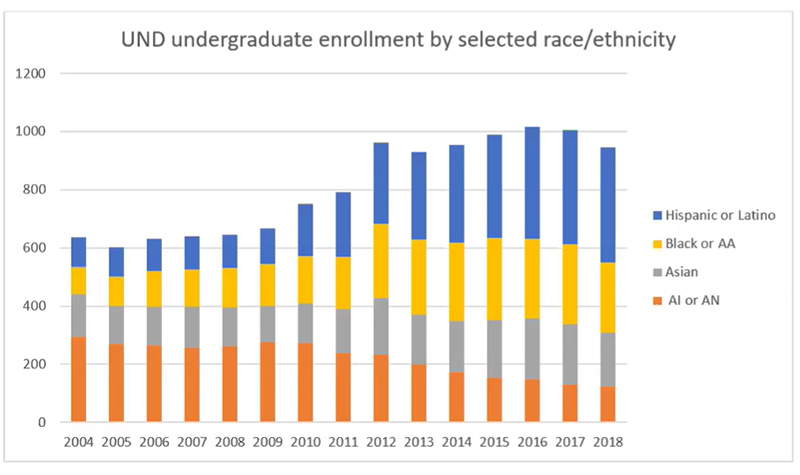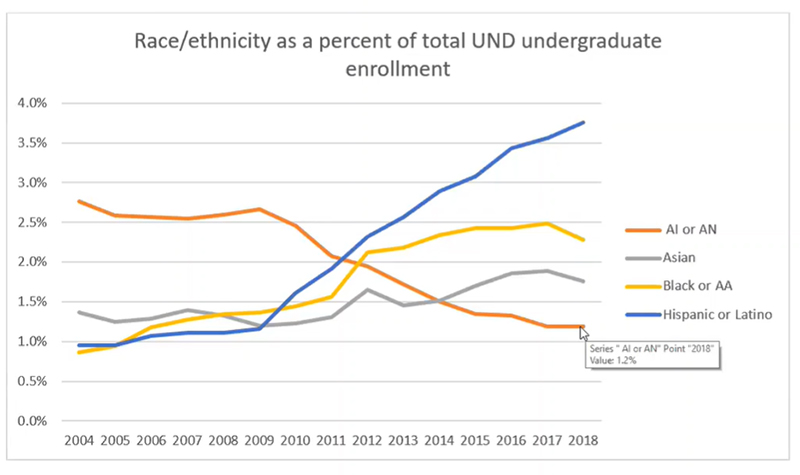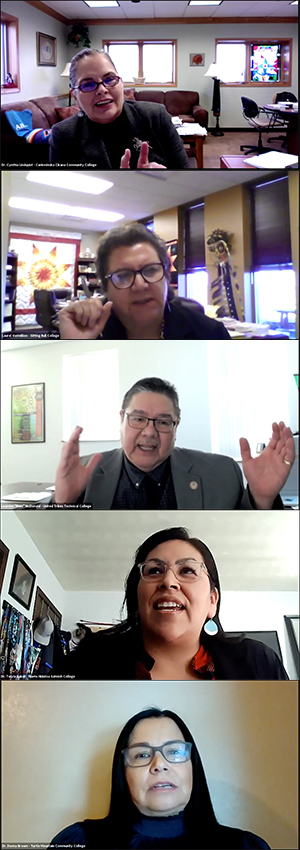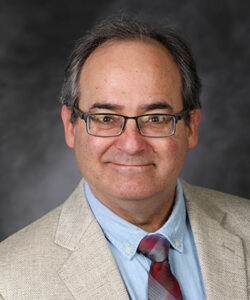Enrollment advice from five very special alums
UND graduates all, North Dakota’s five Tribal College presidents give tips on attracting and retaining American Indian students

When the UND-degree-holding presidents of North Dakota’s five tribal colleges speak, UND listens.
Especially when the topic is “Reaching Underserved Populations,” as it was at a special event Wednesday sponsored by the Task Force on the Future of Education at UND.
The Task Force, an initiative launched by UND Interim Provost Debbie Storrs, is charged with educating the University community about the big issues facing UND and higher education today. The five Tribal College presidents met via Zoom in an open session with Task Force co-chairs Jeff VanLooy, associate professor of Earth System Science & Policy, and John Shabb, associate professor of Biomedical Sciences. During the meeting, the presidents talked about how they’d come to UND and how they’d succeeded at the University.
Then they offered frank advice about how UND could reinvigorate that process – advice that the University is actively seeking out, given that recent years have seen an increase in overall diversity at UND, but a decline in the number of American Indian students.
“Presidents, we can’t thank you enough for your insights and your wisdom about what will make your colleges successful, the challenges that you face and the challenges that we face at UND, as well as the opportunities for partnership,” UND President Andy Armacost said to the group.
The presidents’ hour-long conversation can be watched at the Task Force’s web page.
Here to listen
Wednesday’s event served as a listening session for the University, and the Tribal College presidents said they were grateful that UND had invited them and was soliciting their views.
“I’m looking at the participant list (for the Zoom meeting), and I’m seeing, like, 140 people,” said Cynthia Lindquist, president of Cankdeska Cikana Community College in Fort Totten, N.D., and the holder of a bachelor’s and a doctoral degree from UND.
The size of the audience was impressive, and “thank you so much for your interest. … There are very, very good people at UND, people whom I attribute my success to. Many of them have retired, and that concerns me. But I’m very, very hopeful and optimistic,” especially because President Armacost has shown a clear interest in helping Native students succeed and forging partnerships with tribal colleges, she said.
Besides Lindquist, the other Tribal College presidents who took part were Donna Brown of Turtle Mountain Community College in Belcourt, Laurel Vermillion of Sitting Bull College in Fort Yates, Twyla Baker of Nueta Hidatsa Sahnish College in New Town and Leander “Russ” McDonald of United Tribes Technical College in Bismarck.
Brown, Vermillion, Baker and McDonald each earned their bachelor’s, master’s and doctoral degrees at UND.
In a series of PowerPoint slides, Task Force co-chair Shabb provided background information for the meeting.
As the slides show, the news is mixed when it comes to UND’s recent efforts to boost diversity, Shabb said.
“There are two things to note,” Shabb said. “One is that there has been a steady diversification in our undergraduate student population.” In 2004, fewer than 10 percent of students would have identified as other than white, but by 2018, that percentage had more than doubled, he said.


Meanwhile, though, “there’s been a steady decline over this same period of time” in the number of students who identify as American Indian or Alaska Native. The fact that Black, Asian and (especially) Hispanic or Latino enrollments have jumped accounts for the improved diversity numbers. But UND is concerned about the drop in American Indian enrollment and would like to reverse it, Shabb said.
In part, UND’s numbers may reflect a national decline in the number of American Indian or Alaska Native students attending college. According to data from the Integrated Postsecondary Educational Dataset, there was a 25 percent decrease in American Indian or Alaska Native undergraduate students matriculating at degree-granting institutions from 2010-11 to 2015-16. (On average, Tribal Colleges also saw a loss – but a less severe one – during that period.)
But to the extent that stopping the decline at UND and then reversing it is possible, UND is all ears.
“You all have been on this campus, you all received degrees on this campus, but probably somewhere in the 2004 or earlier period, when there was a larger representation of American Indians on our campus,” Shabb said to the presidents.
So, he asked, any ideas about the changes over the years that might help explain the enrollment drop?
Sorely missed

“I can go first,” said Donna Brown of Turtle Mountain Community College.
“I can’t help but correlate it with the fact that the staff at the (University’s) American Indian Center has dwindled to almost nothing. And there isn’t a dedicated American Indian Student Services staff. …
“I haven’t done a survey, but I can’t help but see a relationship between the dwindling American Indian Student Services staff and the decrease in enrollment of American Indian students,” Brown said.
Lindquist agreed. “People need a place to congregate,” she said. “Native people in particular, we really like socialization. Of course, any student likes socialization, but you’d like to be around people you know or who are like you, so you can ask your questions and not be afraid of that.”
In 2017 and 2018, after the retirement of its longtime Director Leigh Jeanotte, AISS was folded into other diversity programs at UND, and cuts to UND’s overall budget prompted reductions in staff. “I understand budgetary concerns,” said Baker of Nueta Hidatsa Sahnish College.
“But when you stop putting resources toward support of students, this is what’s going to happen.”
McDonald and Vermillion agreed as well. And to understand the presidents’ unanimity, UND should understand that AISS had been instrumental in not only drawing the presidents to UND as students, but also keeping them on campus to graduate, the five said.
That’s because AISS offered the closest thing on campus to a tribal college environment, Baker said.
“Folks who are familiar with tribal colleges know that the types of students we work with might be first generation, might not have the scaffolding that other students have in regards to higher ed, might not know what a FAFSA (Free Application for Federal Student Aid) is or how to fill it out,” she said.
“I think the success of tribal colleges is the fact that we are incredibly personal. … We know the students’ struggles. We know their families and everything. It’s a family-type feel when you’re on a tribal college campus, and we have a vested interest in their success.”
At UND, if you couple that kind of supportive environment with Jeanotte and his staff’s statewide influence and reach, you’ll sense what was lost when AISS was diminished, Baker said.
Said McDonald of United Tribes Technical College, “I’m in total agreement. … Think about where I was coming from (as a student). In my home community, the Spirit Lake Reservation, we’re the majority. Then I move to another community – UND and Grand Forks – where I am the minority.”
For such students, “we need that resource, a place where we can gather,” he said. At AISS, students could talk, sing, meet with advisors and enjoy popular get-togethers such as Soup Fridays.
“I think that’s really the main thing that helped me to get through UND,” McDonald said. “And I think it helped the pipeline of Native students to UND.”
Forging partnerships
Besides reconstituting American Indian Student Services or something like it, UND should strengthen its connections with the tribal colleges, because doing so can likewise lead to an influx of Native students, the presidents said.
For example, faculty exchanges “would be a great thing to do,” Vermillion of Sitting Bull College said. “We have several faculty here who have PhDs, so they’re well-qualified to teach at UND as well.”
Another idea: make more use of the cohort model, in which students enter a program and work through it as a group. The model is a great way to overcome Native students’ worries about feeling lonely, isolated and in-over-their-heads on campus, Vermillion said.
“All of my degrees were through a cohort model,” she said.
“That model worked really well for me, and it works really well for a lot of Native Americans, because like Cindy said, we like that socialization. We like that support we give each other.”
UND also should set up more 2+2 programs, where students who spend two years at a tribal college can transfer readily to UND, Lindquist said.
“Right now, the Social Work program between my college and UND is thriving,” Lindquist said. “It’s absolutely thriving.” Students who take part can make a seamless transition from one school to the other, earn their bachelor’s degree in four years and save money, given that Cankdeska Cikana tuition is only $1,500 per semester.
Summer programs for American Indian middle- and high-school students also would build those students’ familiarity with UND, the Tribal College presidents said.
All of the above efforts would take time and money, Brown said. But here’s why they’d still be worthwhile:
“I was the first one in my family to get a degree from UND,” she said.
“I am very proud to say that 11 more of my family members have received degrees since then. … So you know, helping one student starts that legacy of more family members coming to the college.
“And so, my plea to you is to value the education that our Tribal College students come to your college with, and nurture that.”



